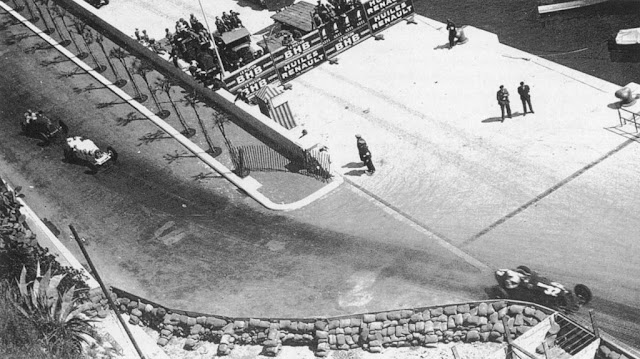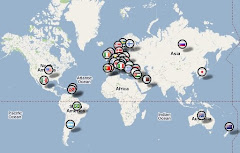Since the first cars rolling out of the manufacturers' garage doors, people have been racing cars and motorcycles. To do that, they needed some sort of environment to sacrifice at the altar to their passion. Empty fields, public roads in the country or in cities, then purpose built venues all have been serving as arenas for petrolheads and motoring enthusiasts since then. Some of these venues have been there since motoring Genesis, some of them are not. Here is a list of the top 10+1 of them.
(Editor's note: All images are courtesy of Google. click the images for the actual Google Maps/Streetview spot.)
10. Circuit Bremgarten
The Bremgarten Circuit - in the outskirts of the Swiss capital, Bern - was designed with motorcycles in mind, although when opened in 1931, motorcars soon took over and become one of the most fearsome tracks, especially under wet conditions - largely due to having virtually no straight lines and a chain of public roads. It was on Formula 1 calendar from the beginning, but the disastrous accident at the 1955 Le Mans 24 Hours lead to banning all motorsports in Switzerland. To this day, no racing was held at the venue, nor in the country except a few non-track events.
9. Bridgehampton Race Circuit
Bridgehampton, NY, USA has a long history of motor racing, dating back to 1915. Early road races proved to be such a success that lead to the establishment of the permanent Bridgehampton Race Circuit in 1957. In its prime time it served as the scenery of World Sportscar Championship, Can-Am, NASCAR, IMSA GT Championship, and it saw the return of the legendary Vanderbilt Cup in the late 60s. Few, but technical turns for sport cars. Unfortunately, due to a lack of finance, the track was was dating out quickly, and by the early seventies there were virtually no pro-events held at this place. In 1999 it was converted to a golf course. Slowing down the pace a bit, right?
8. Daytona Beach Road Course
The sands of Daytona, Florida is basically the birthplace of American motor racing. In the late 1800s, early 1900s it served as the spot of land speed record breaking, but due to the narrow dry area it quickly became unfitting as speeds were growing higher and there was a constantly decreasing forgiveness for mistakes. Thus, speed hunters moved to the Bonneville Salt Flats, racing enthusiasts went on to race at the Indianapolis Motor Speedway, and those who lacked money started racing here. The Prohibition gave rise the 'moonrunners', who, after the amendment was erased, joined the races with their tuned, outlaw cars and so NASCAR was born. The venue consisted of one long straight line on the beach, and another one on a public road, with two sharp turns. As the success of NASCAR races were growing in the fifties, the scenery was proved to be too small, only to be replaced by the Daytona International Speedway in 1959.
7. Brooklands
The first ever purpose-built racing venue, preceding IMS a few years, opening in 1907. A banked oval with three turns, also serving as an airport for smaller planes. The track is of unpaved concrete panels and was a perfect venues for V-max attempts and Grand Prix races. There was a vibrant scene until WWII broke out in 1939, and racing was stopped, moreover, it never returned for the track. Parts of the circuit are street roads, or just decaying slowly.
6. Pescara Circuit
The Pescara Circuit is the longest ever in the history of Formula 1 World Championship with its near-26km length. Two long straights meeting in an almost 90 degree-corner and zig-zag pieces of roads connecting the open ends, through towns. The track has been not unknown to Italian drivers as it was holding local races since the 1920s, and later non-champ and one official Formula 1 race event in 1957. As with every lengthy course, it proved to be too dangerous, and racing was ended in 1961.
5. Reims-Gueux
It's the beauty of the countryside, the endless hayfields that captures the eye of the trespasser between these small French villages. It hosted sports car and Grand Prix events, too, including Formula 1 races, from the late '20s all the way through the early '70s. The old grandstand and the pits are still at where they are supposed to be, would simply be a perfect backdrop for any vintage racing event.
4. Rouen-Les-Essarts
Laid out on public roads near Rouen, France, the track was a state-of-the-art one concerning its infrastructure along with its 'Nürburgringuesqe' characteristics - running deep in the forest with high-speed blind corners and its roller coaster-like height differences. Opening in one of motor sport history's greatest year, 1950, it saw several French Grand Prix races, and was considered to be technically highly demanding. This resulted in the unfortunate death of Jo Schlesser in 1968. The circuit was still open for F2 races, but ultimately it had to be closed in 1994.
3. Tripoli Circuit
Around the airport of Libya's capital, you can still find stretches of public roads that once belonged to the then-Italian colony's monstrous Grand Prix venue, opened in 1925. Everything was big here. The track with its 13-km length and few and fast corners it was designed for sole flat-out speed. This made it one of the most important events among racing tracks in the horsepower chasing, top speed seeking period. So much, that Mercedes took their regular test track, former motorcycle racetrack and converted it to a similar to it in character - thus Hockenheimring was born. The Tripoli track was an amazing sight with its enormous grandstand, the palm trees, the sand. The motoring proving grounds of the fascist-nazi regimes closed its gates in 1940.
2. AVUS
Along with the Nürbirgring, the AVUS in Berlin was an important part of Nazi Germany's propaganda. Conceived in the early 1900s, and after interrupted years' of building, it was completed in 1921, as the first stretch of Autobahn. Two long pieces of roads running in parallel, connected with a sharp turn at the Southern and a bigger one in the Northern end, making up 19km of length. The track went through several changes by cutting it in half and constructing a highly banked brick-paved 'Wall of Death' on the Northern part. Average speed was higher than of the IMS, standing for decades. Later, the 'WoD' was demolished, cutting the track in half again, and once again, concluding in 2.6km with chicanes added. Every major German race was held here, even the 1959 Formula 1 German Grand Prix. 40 years later, in 1999 it all came to an end and races were moved to the new Lausitzring.
1. Montjuïc Circuit
Maybe not the most demanding one, not the fastest, but one of the most classic one. Situated in the park of the same name in Barcelona, Spain, the venue was a host for tragedies, supreme winnings and yet the only female-obtained points in Formula 1. Just think of Jackie Stewart flying through the corners in a Tyrell and you'll see why it is number 1.
+1. Népliget
I have no excuses. I am biased. But I have common sense too, hence +1. Read more here.

























